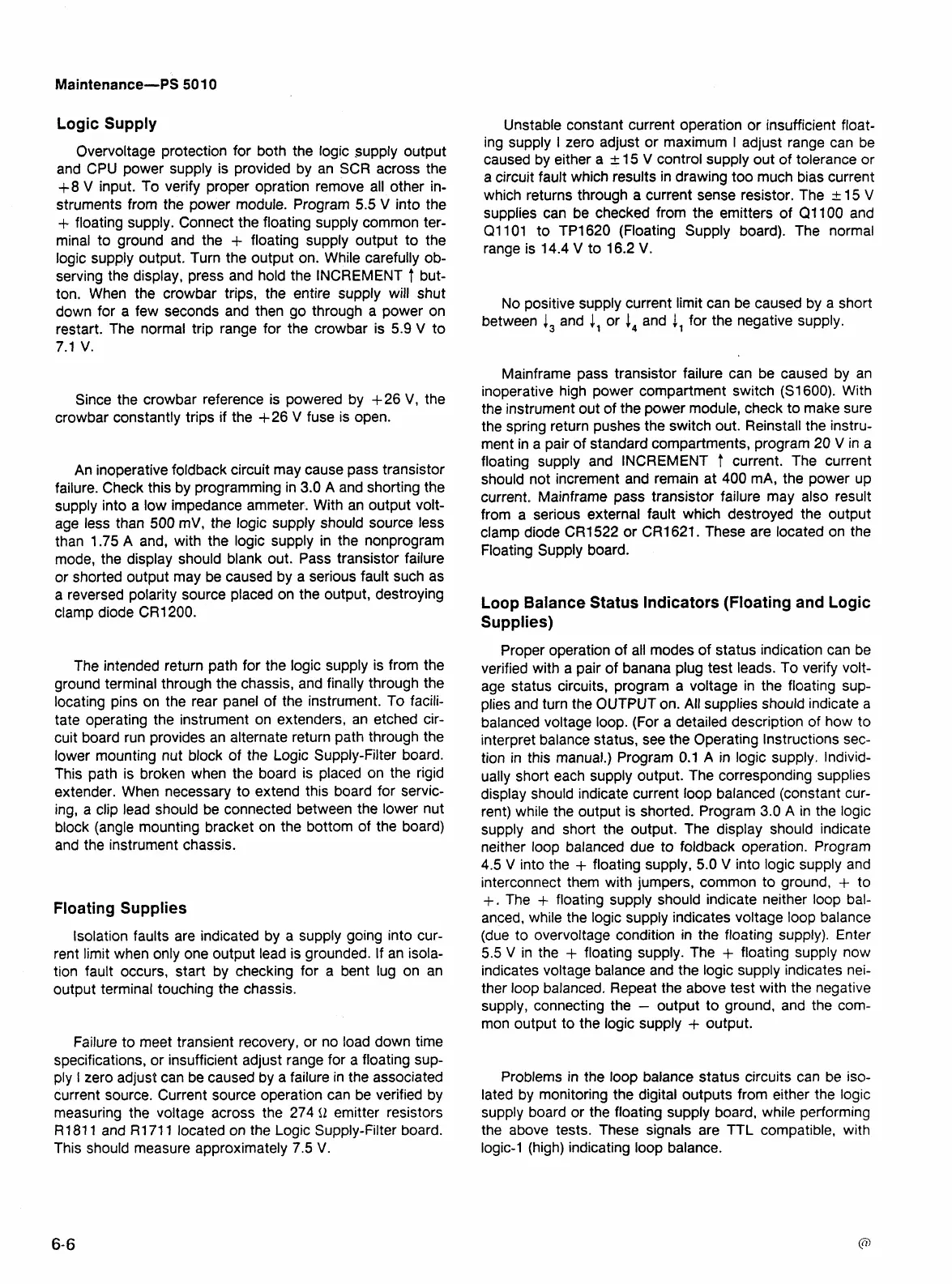Logic Supply
Overvoltage protection for both the logic supply output
and CPU power supply is provided by an SCR across the
+8
V
input. To verify proper opration remove all other in-
struments from the power module. Program 5.5
V
into the
$-
floating supply. Connect the floating supply common ter-
minal to ground and the
+
floating supply output to the
logic supply output. Turn the output on. While carefully ob-
serving the display, press and hold the INCREMENT
t
but-
ton. When the crowbar trips, the entire supply will shut
down for a few seconds and then go through a power on
restart. The normal trip range for the crowbar is
5.9
V
to
7.1 V.
Since the crowbar reference is powered by +26 V, the
crowbar constantly trips if the +26
V
fuse is open.
An inoperative foldback circuit may cause pass transistor
failure. Check this by programming in 3.0 A and shorting the
supply into a low impedance ammeter. With an output volt-
age less than 500 mV, the logic supply should source less
than 1.75 A and, with the logic supply in the nonprogram
mode, the display should blank out. Pass transistor failure
or shorted output may be caused by a serious fault such as
a reversed polarity source placed on the output, destroying
clamp diode
CR1200.
The intended return path for the logic supply is from the
ground terminal through the chassis, and finally through the
locating pins on the rear panel of the instrument. To facili-
tate operating the instrument on extenders, an etched cir-
cuit board run provides an alternate return path through the
lower mounting nut block of the Logic Supply-Filter board.
This path is broken when the board is placed on the rigid
extender. When necessary to extend this board for servic-
ing, a clip lead should be connected between the lower nut
block (angle mounting bracket on the bottom of the board)
and the instrument chassis.
Floating Supplies
Isolation faults are indicated by a supply going into cur-
rent limit when only one output lead is grounded. If an isola-
tion fault occurs, start by checking for a bent lug on an
output terminal touching the chassis.
Failure to meet transient recovery, or no load down time
specifications, or insufficient adjust range for
a
floating sup-
ply
I
zero adjust can be caused by a failure in the associated
current source. Current source operation can be verified by
measuring the voltage across the 274
I1
emitter resistors
R
1
81
1
and
R
171 1 located on the Logic Supply-Filter board.
This should measure approximately 7.5
V.
Unstable constant current operation or insufficient float-
ing supply
I
zero adjust or maximum I adjust range can be
caused by either a
+
15
V
control supply out of tolerance or
a circuit fault which results in drawing too much bias current
which returns through
a
current sense resistor. The
+
15
V
supplies can be checked from the emitters of Q1100 and
Q1101 to TP1620 (Floating Supply board). The normal
range is 14.4 V to 16.2 V.
No positive supply current limit can be caused by a short
between
/,
and
4,
or
1,
and
1,
for the negative supply.
Mainframe pass transistor failure can be caused by an
inoperative high power compartment switch (S16OO). With
the instrument out of the power module, check to make sure
the spring return pushes the switch out. Reinstall the instru-
ment in a pair of standard compartments, program 20
V
in a
floating supply and INCREMENT
t
current. The current
should not increment and remain at 400 mA, the power up
current. Mainframe pass transistor failure may also result
from a serious external fault which destroyed the output
clamp diode
CR1522 or CR1621. These are located on the
Floating Supply board.
Loop Balance Status Indicators (Floating and Logic
Supplies)
Proper operation of all modes of status indication can be
verified with a pair of banana plug test leads. To verify volt-
age status circuits, program a voltage in the floating sup-
plies and turn the OUTPUT on. All supplies should indicate a
balanced voltage loop. (For a detailed description of how to
interpret balance status, see the Operating Instructions sec-
tion in this manual.) Program
0.1
A
in logic supply. Individ-
ually short each supply output. The corresponding supplies
display should indicate current loop balanced (constant cur-
rent) while the output is shorted. Program 3.0
A
in the logic
supply and short the output. The display should indicate
neither loop balanced due to
foldback operation. Program
4.5
V
into the
+
floating supply, 5.0 V into logic supply and
interconnect them with jumpers, common to ground,
+
to
+.
The
+
floating supply should indicate neither loop bal-
anced, while the logic supply indicates voltage loop balance
(due to overvoltage condition in the floating supply). Enter
5.5
V
in the
+
floating supply. The
+
floating supply now
indicates voltage balance and the logic supply indicates nei-
ther loop balanced. Repeat the above test with the negative
supply, connecting the
-
output to ground, and the com-
mon output to the logic supply
+
output.
Problems in the loop balance status circuits can be iso-
lated by monitoring the digital outputs from either the logic
supply board or the floating supply board, while performing
the above tests. These signals are
TTL
compatible, with
logic-1 (high) indicating loop balance.

